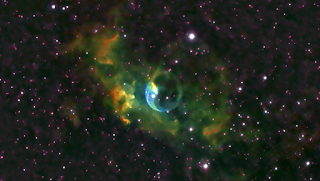My New Toy
Early this summer I was out imaging with my usual setup, Canon T3i on a Tele Vue NP101. When my first image appeared on my monitor of M8, and M20 I was uninspired. It was a great image of one of my favorite objects, but it looked the same as last year and the year before. I gathered about 20 frames and the next day I processed them into a nice Image. Over the past 7 years my imaging and processing skills have greatly improved to the point I can easily get good results. Don't get me wrong there is always room for improvement, I just think I was getting board with wide field imaging. I decided to change tactics and go after smaller objects like galaxies and planetary nebula. Looking online I came across an interesting and discounted and discontinued camera. This ZWO ASI290MM Cooled camera seem to fit the bill, a small monochrome CCD sensor with small pixels, and cooled. Once you decide to get a Monochrome camera your gonna need to spend more money on filters, and a filter wheel. I chose the ZWO motorized 5 position filter wheel, and found used LRGB, and SHO filters on Canadian Astro Buy Sell. That saved me quite a bit.
 |
| ZWOASI290MM Cool |
|
 |
| Front, showing the sensor |
|
 |
| LRGB Filters |
|
 |
| ZWO Filter Wheel with SHO Filters |
|
 |
| All assembled and attached to the Scope |
|
prove
Since it is a monochrome camera, filters are required to produce a
colour image. A regular colour image uses LRGB filters. L= luminance,
R=Red, G=Green, B=Blue. To produce a colour image, multiple exposures
threw each filter is required then combined in processing. These below
images where produced using separate LRGB frames processed in Photoshop
CC 2020. They are my first attempts and there is plenty of room for imment. Better images to follow.
 |
| Galaxy NGC891 |
 |
| The Helix nevbula |
Using another set of filters, more dramatic results can be Produced. SHO, also known as the Hubble Palate. SII=Sulphure, Ha=Hydrogen, and OIII=Oxygen. Capturing the images is done using the same technique but, the final processing is a bit different. You combine the colours differently. The SII becomes Red, Ha becomes Green, and the OIII becomes Blue. These Images below are done in this method. Again they are a work in progress.
 |
| M16 The Eagle Nebula |
 |
| The Bubble Nebula |
The image of the M1 (The Crab Nebula) was also processed using SHO frames. The images below show the 3 seperate SHO pictures converted to RGB images. Then the final image combined to Full SHO colour.
 |
| Red = SI |
 |
| Green = Ha |
 |
| Blue = OIII |
 |
| The Crab Nebula in Full Colour. |
Some objects only mostly produce Ha, Deep Red so they look best as Black and White, otherwise known as Monochrome images. Below are a few examples.
 |
| he HorseHead Nebula |
|
 |
| From the 2020 RASC Calendar. (Top) Elephant Trunk, (B Left) M16, (B Right) Bubble Nebula. |














